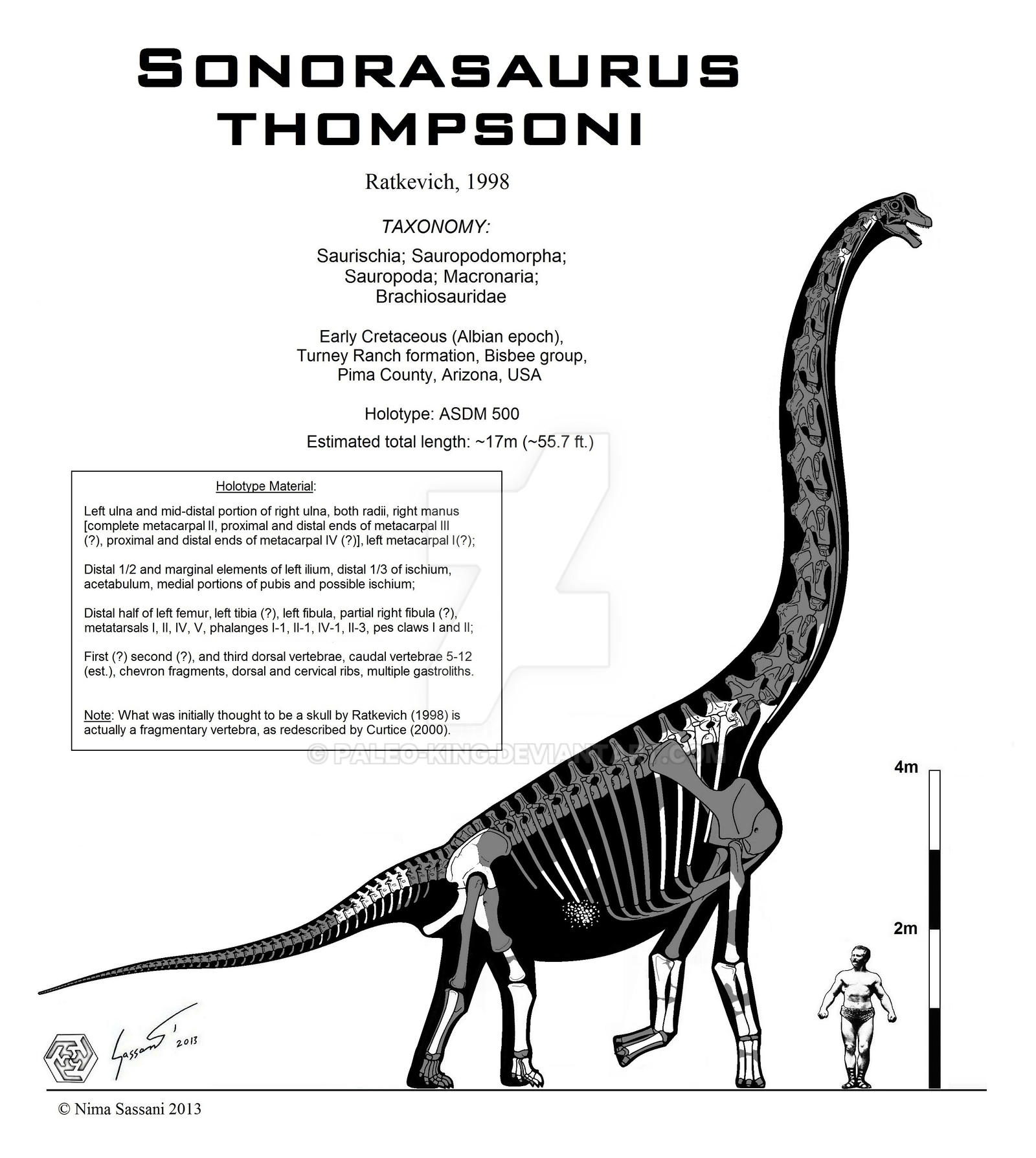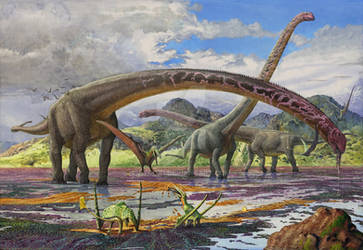ShopDreamUp AI ArtDreamUp
Deviation Actions
Description
Etymology: "Thompson's Sonoran Desert lizard" (after the Sonoran Desert in Arizona and for then-student of geology Richard Thompson)
Time horizon: Mid-Cretaceous, Albian-Cenomanian stages (~112-93 mya)
Length: ~17m (~55.7 ft.)
Probable mass: 20 tons, perhaps more based on maturity
Sonorasaurus was a late-stage brachiosaur (in fact probably as late-stage as you can get in this family's evolutionary history, without bringing up that quasi-crypto report of brachiosaur tail material in Mexico from supposedly Maastrichtian-age rock layers). As a result this is a very important animal for understanding the changes undergone by the group during the Cretaceous, a time when they gradually went from being incredibly successful survivors of the LJ-EK mass extinction, to being increasingly rare and out of their element. This is clear at least in North America, where the inland sea and increasingly swampy climate during the mid-Cretaceous gradually pushed all surviving sauropods (brachiosaurs, chubutisaurs and other basal titanosauriforms) towards extinction. Due to the lack of extensive research on cretaceous brachiosaurs elsewhere, it is hard to tell exactly what caused them to die out or how long they actually survived into the Cretaceous before being fully supplanted by titanosaurs (they seem to have dominated England for a long time, and tantalizing clues about their Cretaceous presence in Argentina, Lebanon, and even China have turned up).
Sonorasaurus was described by Ron Ratkevich in 1998, an quickly brought attention to Arizona as a dinosaur state. Yet it failed to become Arizona's state dinosaur. One thing notable about this species is that its basic design, specifically the arms, seems little changed from far older Jurassic brachiosaurs, indicating either that it's from a particularly old bloodline within the group (perhaps akin to B. altithorax) or that brachiosaurs in general changed little over their history. It does, however, appear to be different and more basal in morphology than the Cedarosaurus-Abydosaurus lineage, though there are still a lot of unanswered questions about this animal and any full-body reconstruction so far still requires a lot of speculation. A cast of the arm as well as the the original dig site is on outdoor display near the Sonoran Desert museum where its bones are housed (next to a rather ugly mid-90s style water fountain ).
).
Like Cedarosaurus, there were stomach clasts found with this animal, which further indicates that even brachiosaurs were not chewers, though they were better adapted to hacking through tough branches than diplodocoids. The remains indicate very long and gracile hands, but much more compact hindfeet, even by brachiosaur standards. Ratkevich intially mentioned a crushed skull being found with the skeleton, though on closer analysis by Curtice (2000) the object turned out to be a vertebra. Interestingly enough, a music app for iPhone has been named after Sonorasaurus: www.sonorasaurus.com/
REFERENCES:
Ratkevich, R (1998). "New Cretaceous brachiosaurid dinosaur, Sonorasaurus thompsoni gen et sp. nov, from Arizona." Arizona-Nevada Academy of Science 31; 71-82.
Time horizon: Mid-Cretaceous, Albian-Cenomanian stages (~112-93 mya)
Length: ~17m (~55.7 ft.)
Probable mass: 20 tons, perhaps more based on maturity
Sonorasaurus was a late-stage brachiosaur (in fact probably as late-stage as you can get in this family's evolutionary history, without bringing up that quasi-crypto report of brachiosaur tail material in Mexico from supposedly Maastrichtian-age rock layers). As a result this is a very important animal for understanding the changes undergone by the group during the Cretaceous, a time when they gradually went from being incredibly successful survivors of the LJ-EK mass extinction, to being increasingly rare and out of their element. This is clear at least in North America, where the inland sea and increasingly swampy climate during the mid-Cretaceous gradually pushed all surviving sauropods (brachiosaurs, chubutisaurs and other basal titanosauriforms) towards extinction. Due to the lack of extensive research on cretaceous brachiosaurs elsewhere, it is hard to tell exactly what caused them to die out or how long they actually survived into the Cretaceous before being fully supplanted by titanosaurs (they seem to have dominated England for a long time, and tantalizing clues about their Cretaceous presence in Argentina, Lebanon, and even China have turned up).
Sonorasaurus was described by Ron Ratkevich in 1998, an quickly brought attention to Arizona as a dinosaur state. Yet it failed to become Arizona's state dinosaur. One thing notable about this species is that its basic design, specifically the arms, seems little changed from far older Jurassic brachiosaurs, indicating either that it's from a particularly old bloodline within the group (perhaps akin to B. altithorax) or that brachiosaurs in general changed little over their history. It does, however, appear to be different and more basal in morphology than the Cedarosaurus-Abydosaurus lineage, though there are still a lot of unanswered questions about this animal and any full-body reconstruction so far still requires a lot of speculation. A cast of the arm as well as the the original dig site is on outdoor display near the Sonoran Desert museum where its bones are housed (next to a rather ugly mid-90s style water fountain
Like Cedarosaurus, there were stomach clasts found with this animal, which further indicates that even brachiosaurs were not chewers, though they were better adapted to hacking through tough branches than diplodocoids. The remains indicate very long and gracile hands, but much more compact hindfeet, even by brachiosaur standards. Ratkevich intially mentioned a crushed skull being found with the skeleton, though on closer analysis by Curtice (2000) the object turned out to be a vertebra. Interestingly enough, a music app for iPhone has been named after Sonorasaurus: www.sonorasaurus.com/
REFERENCES:
Curtice, B., 2000, The axial skeleton of Sonorasaurus thompsoni (Ratkevich, 1998): Southwest Paleontological Symposium, Mesa Southwest Museum Bulletin, v. 7, p. 83-87.
Ratkevich, R (1998). "New Cretaceous brachiosaurid dinosaur, Sonorasaurus thompsoni gen et sp. nov, from Arizona." Arizona-Nevada Academy of Science 31; 71-82.
Image size
2984x3336px 1.17 MB
© 2016 - 2024 Paleo-King
Comments14
Join the community to add your comment. Already a deviant? Log In
Imagine Brachiosaurid seeing Titanosaurs like.. Hi there, I haven't seen you around, are you new here?































